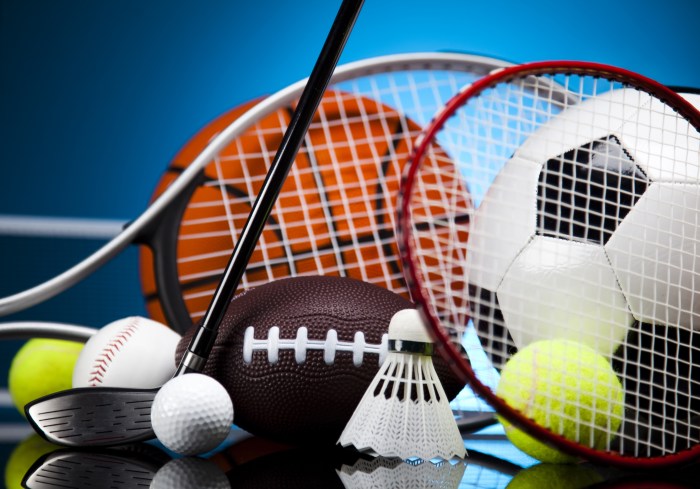Sports And Hobbies are experiencing a global surge in popularity, impacting economies, mental well-being, and social connections in profound ways. This exploration delves into the diverse landscape of athletic pursuits and leisure activities, examining participation trends across demographics, the psychological and physical benefits, the social dynamics involved, and the crucial role of equipment and resources. We’ll also look ahead to the future of sports and hobbies, considering emerging technologies and their potential influence.
From the professional leagues drawing millions of viewers to the solitary pursuits of crafting or gardening, the unifying thread is the enriching experience they provide. This analysis dissects the economic impact of these activities, examining how they contribute to local and national economies through participation fees, equipment sales, and tourism. We’ll also consider the less tangible benefits, such as improved mental health and stronger community bonds.
The Popularity of Sports and Hobbies

The global landscape of leisure activities is dynamic, reflecting evolving societal trends, technological advancements, and economic factors. Participation in sports and hobbies is not merely a pastime; it’s a significant economic driver, contributing substantially to local and national economies through tourism, equipment sales, and the creation of jobs. Understanding the patterns of participation across demographics and geographic regions provides valuable insights into consumer behavior and societal well-being.
Global Trends in Sports and Hobby Participation
Participation rates in sports and hobbies vary considerably across the globe, influenced by factors such as cultural norms, access to facilities, and disposable income. While traditional team sports like soccer and basketball maintain widespread popularity, there’s a noticeable rise in participation in individual activities like running, cycling, and yoga, reflecting a growing emphasis on personal fitness and well-being. Emerging trends include the increasing popularity of e-sports and virtual reality-based activities, particularly among younger demographics.
Data from organizations like the World Health Organization and national sporting federations offer valuable insights into these evolving trends, revealing regional variations and the impact of government initiatives promoting physical activity. For instance, initiatives promoting cycling infrastructure in European cities have demonstrably increased cycling participation rates.
Comparative Analysis of Participation Rates Across Demographics
Participation in sports and hobbies shows significant variation across age groups and demographics. Younger generations often demonstrate a higher engagement with digital and technology-driven activities, while older demographics tend to gravitate towards traditional sports and hobbies. Gender also plays a role, with certain sports traditionally dominated by one gender showing signs of increasing inclusivity. Socioeconomic factors also influence participation, with access to resources and facilities often determining the range of activities available.
Studies comparing participation rates across different income brackets often reveal a correlation between disposable income and the diversity of leisure activities undertaken. For example, higher-income groups may participate in more expensive hobbies like golf or sailing, compared to lower-income groups who may engage in more affordable activities like running or team sports.
Economic Impact of Sports and Hobbies
The economic contribution of sports and hobbies is substantial, extending beyond the direct spending on equipment and participation fees. The tourism industry benefits significantly from sporting events and recreational activities, attracting visitors and generating revenue for local businesses. The manufacturing and retail sectors also benefit from the demand for sporting goods and equipment. Furthermore, the sports and hobbies sector creates numerous jobs, from coaches and instructors to equipment manufacturers and retail staff.
A significant indirect impact also exists through increased health and well-being, leading to reduced healthcare costs and increased productivity. For example, the economic impact of the Olympic Games on host cities is well-documented, showcasing the potential for large-scale events to stimulate economic growth.
Most Popular Sports and Hobbies Worldwide
The following table provides a snapshot of the most popular sports and hobbies worldwide, categorized by region. Note that data collection methodologies vary across regions, making direct comparisons challenging. This table represents a general overview based on available data from various sources.
| Region | Sport/Hobby | Sport/Hobby | Sport/Hobby |
|---|---|---|---|
| North America | Basketball | Baseball | American Football |
| Europe | Soccer | Cycling | Tennis |
| Asia | Cricket | Badminton | Table Tennis |
| South America | Soccer | Volleyball | Martial Arts |
| Africa | Soccer | Running | Traditional Games |
The Physical Benefits of Sports and Hobbies
Engaging in regular physical activity, whether through organized sports or leisure hobbies, offers a wide array of physical health benefits. These advantages extend beyond weight management and muscle strength, impacting cardiovascular health, bone density, and overall well-being. The intensity and type of activity influence the specific benefits derived, highlighting the importance of choosing activities suited to individual fitness levels and goals.
Cardiovascular Health Improvements Through Sports and Hobbies
Regular participation in sports and hobbies significantly improves cardiovascular health. Activities like running, swimming, cycling, and team sports such as basketball or soccer elevate the heart rate, strengthening the heart muscle and improving its efficiency. This leads to lower resting heart rates, reduced blood pressure, and a decreased risk of heart disease, stroke, and other cardiovascular ailments. Even moderate-intensity hobbies, such as brisk walking, gardening, or dancing, contribute positively to cardiovascular fitness.
The American Heart Association recommends at least 150 minutes of moderate-intensity or 75 minutes of vigorous-intensity aerobic activity per week for optimal cardiovascular health. Consistent engagement in chosen activities, tailored to individual capabilities, is key to realizing these benefits.
Musculoskeletal System Strengthening, Sports And Hobbies
Many sports and hobbies directly contribute to the strength and health of the musculoskeletal system. Weight-bearing activities, such as hiking, tennis, and weightlifting, increase bone density and reduce the risk of osteoporosis. Resistance training, whether through dedicated workouts or activities like rock climbing or kayaking, builds muscle mass and strength, improving posture, balance, and overall physical function. Conversely, activities with lower impact, such as swimming or yoga, provide excellent cardiovascular benefits while minimizing stress on joints.
The choice of activity should consider individual needs and limitations, ensuring a balance between challenge and safety.
Physical Demands Across Different Hobbies
The physical demands of various hobbies vary considerably. Gardening, for example, involves moderate physical activity, improving flexibility and cardiovascular health. In contrast, activities like rock climbing or marathon running demand significantly higher levels of physical fitness, strength, and endurance. Hobbies such as knitting or painting are less physically demanding but still offer benefits like improved hand-eye coordination and stress reduction.
Understanding the physical requirements of a chosen hobby allows individuals to assess their fitness level and adjust their participation accordingly, preventing injury and maximizing benefits.
Injury Prevention and Proper Training in Sports
Proper training and injury prevention are crucial for maximizing the benefits of sports participation while minimizing risks. This includes appropriate warm-up and cool-down routines, gradual progression of training intensity, and proper technique. Adequate rest and recovery are equally vital, allowing the body to repair and rebuild. Ignoring these principles can lead to overuse injuries, muscle strains, and other ailments.
Seeking guidance from qualified coaches, trainers, or physical therapists can significantly reduce the risk of injury and ensure safe and effective training programs. For example, a runner who increases their mileage too quickly risks stress fractures, while a weightlifter using improper form may injure their back.
Impact of Regular Hobby Participation on Overall Fitness
Regular participation in hobbies contributes significantly to overall fitness and well-being. The consistent physical activity improves cardiovascular health, strengthens muscles and bones, and enhances flexibility and balance. Beyond the physical benefits, many hobbies offer mental and emotional advantages, reducing stress and improving mood. The social interaction often associated with group hobbies further enhances overall well-being. For instance, joining a hiking club combines physical activity with social interaction and exploration, contributing to a holistic improvement in health and lifestyle.
The key is to choose hobbies that are enjoyable and sustainable, ensuring long-term commitment and reaping the associated physical and mental health rewards.
The Equipment and Resources Needed for Sports and Hobbies

Participating in sports and hobbies requires a range of equipment and resources, the specific needs varying widely depending on the chosen activity. Access to these resources can significantly impact participation rates and enjoyment, highlighting the importance of understanding both the necessities and strategies for acquiring them affordably. This section examines the equipment needs for several popular activities, strategies for cost-effective acquisition, and the environmental considerations inherent in the production and disposal of sporting goods.
Essential Equipment for Various Sports and Hobbies
The equipment required for different sports and hobbies varies considerably. For instance, a marathon runner primarily needs running shoes, appropriate clothing, and a hydration system. Conversely, a competitive cyclist will require a high-performance bicycle, helmet, cycling apparel, and potentially specialized tools for maintenance. Similarly, hobbies such as painting necessitate brushes, paints, canvases, and easels, while woodworking demands tools like saws, chisels, and a workbench.
The following table provides a concise overview:
| Activity | Essential Equipment |
|---|---|
| Running | Running shoes, athletic apparel, hydration pack |
| Cycling | Bicycle, helmet, cycling apparel, repair kit |
| Painting | Brushes, paints, canvases, easels |
| Woodworking | Saws, chisels, workbench, safety glasses |
| Yoga | Mat, comfortable clothing |
| Photography | Camera, lenses, tripod |
Affordable Acquisition of Equipment and Resources
Securing necessary equipment without excessive financial burden is crucial for widespread participation. Several strategies can facilitate this. Purchasing used equipment through online marketplaces or secondhand sporting goods stores can significantly reduce costs. Renting equipment, particularly for activities with high upfront costs like skiing or scuba diving, is another viable option. Furthermore, many communities offer subsidized or free access to sporting facilities and equipment, promoting broader engagement.
Finally, opting for basic, functional equipment over high-end, specialized gear can substantially lower initial investment without significantly compromising enjoyment. For example, a beginner painter might start with a basic acrylic paint set and brushes before investing in more expensive professional-grade materials.
Environmental Impact of Sporting Goods
The production and disposal of sporting goods present significant environmental challenges. Many products are manufactured using non-renewable resources and generate considerable waste. The manufacturing process often involves energy-intensive procedures and releases harmful emissions into the atmosphere. Furthermore, the durability of some equipment is limited, contributing to a cycle of consumption and disposal. The textile industry, in particular, is a major contributor to environmental pollution, with the production of synthetic athletic wear relying heavily on petroleum-based materials.
Promoting Sustainability in Sports and Hobbies
Adopting sustainable practices is essential to mitigate the environmental impact of sports and hobbies.
- Prioritize durable, repairable equipment over disposable items.
- Support brands committed to sustainable manufacturing practices.
- Purchase used equipment whenever possible.
- Properly recycle or dispose of worn-out equipment responsibly.
- Choose eco-friendly materials whenever feasible (e.g., organic cotton apparel).
- Minimize single-use plastics and packaging.
- Advocate for policies that promote sustainable manufacturing and waste reduction in the sporting goods industry.
The Future of Sports and Hobbies
The convergence of technology, evolving demographics, and shifting societal priorities is reshaping the landscape of sports and hobbies. Traditional activities are being redefined, while entirely new forms of engagement are emerging, promising a dynamic future for leisure and athletic pursuits. This evolution presents both challenges and opportunities for individuals, businesses, and governing bodies alike.
Emerging Trends in Sports and Hobbies
Several key trends are driving the future of sports and hobbies. The rise of e-sports, for instance, has transformed competitive gaming into a global phenomenon, attracting millions of participants and viewers. Simultaneously, a growing interest in personalized fitness experiences, fueled by wearable technology and accessible online training programs, is decentralizing traditional gym memberships. Furthermore, the increasing popularity of outdoor adventure activities, such as hiking, trail running, and climbing, reflects a broader societal shift towards prioritizing mental and physical well-being through connection with nature.
Finally, the gamification of fitness and hobby activities is also gaining significant traction, with apps and platforms offering points, rewards, and social interaction to boost engagement.
The Impact of Technology on Sports and Hobbies
Technology is fundamentally altering how we participate in and experience sports and hobbies. Virtual reality (VR) and augmented reality (AR) technologies are creating immersive and interactive experiences, blurring the lines between the physical and digital worlds. For example, VR is used to simulate realistic training environments for athletes, while AR can overlay digital information onto real-world sporting events, enhancing the spectator experience.
Data analytics, meanwhile, is revolutionizing performance optimization in professional sports and providing personalized feedback to amateur athletes. The proliferation of fitness trackers and smartwatches allows individuals to monitor their activity levels, sleep patterns, and overall health, empowering them to make data-driven decisions about their well-being. This technological integration is not just enhancing performance; it is also democratizing access to training resources and fostering a more inclusive and personalized approach to sports and hobbies.
Challenges and Opportunities for the Future of Sports and Hobbies
The future of sports and hobbies is not without its challenges. The digital divide, for instance, could exacerbate inequalities in access to technology and training resources, limiting participation for certain demographics. Concerns around data privacy and security in the context of wearable technology and online fitness platforms also need careful consideration. However, the opportunities are equally significant.
The growing market for personalized fitness and wellness solutions presents substantial business opportunities, while technological advancements can enhance accessibility for individuals with disabilities. Moreover, the integration of technology can foster a more global and connected community of sports and hobby enthusiasts, fostering collaboration and knowledge sharing on an unprecedented scale.
Predictions for Popular Sports and Hobbies in the Next Decade
Predicting the future with certainty is impossible, but based on current trends, several sports and hobbies are poised for significant growth in the next decade. E-sports will continue its meteoric rise, likely surpassing traditional spectator sports in certain demographics. Personalized fitness experiences, leveraging technology and data-driven insights, will become increasingly prevalent. Outdoor adventure activities will continue to gain popularity, driven by a growing awareness of the mental and physical benefits of nature.
Furthermore, hybrid activities combining physical and digital elements – such as augmented reality fitness games or virtual team sports – are likely to emerge as significant trends. The example of Peloton, a company that successfully blended fitness with technology and community, illustrates the potential of this market segment. The success of Peloton demonstrates the appeal of a cohesive experience combining physical activity, digital interaction, and a sense of community.
Ultimately, the enduring appeal of sports and hobbies lies in their capacity to enhance both individual well-being and social cohesion. Whether it’s the adrenaline rush of competitive sports or the calming focus of a creative hobby, these activities offer invaluable benefits, shaping individuals and communities alike. As technology continues to evolve and societal trends shift, the future of sports and hobbies promises a dynamic and ever-evolving landscape, filled with both challenges and exciting new possibilities.
Understanding these trends and their implications is key to maximizing the positive impact of these essential aspects of human life.


